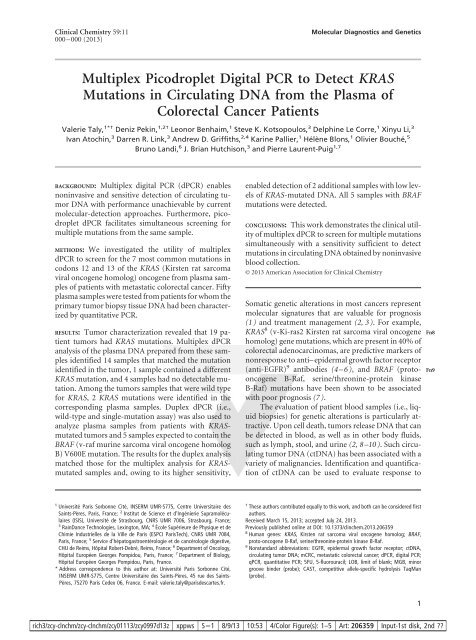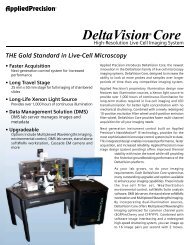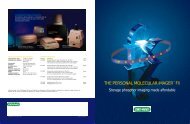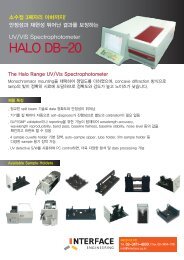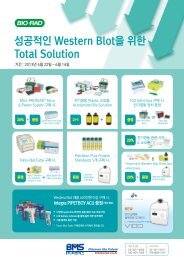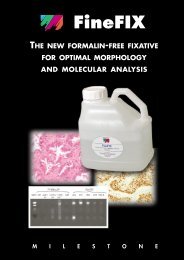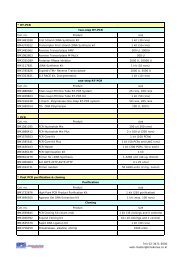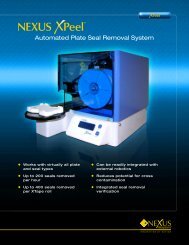Multiplex Picodroplet Digital PCR to Detect KRAS Mutations in ...
Multiplex Picodroplet Digital PCR to Detect KRAS Mutations in ...
Multiplex Picodroplet Digital PCR to Detect KRAS Mutations in ...
Create successful ePaper yourself
Turn your PDF publications into a flip-book with our unique Google optimized e-Paper software.
Cl<strong>in</strong>ical Chemistry 59:11000–000 (2013)Molecular Diagnostics and Genetics<strong>Multiplex</strong> <strong>Picodroplet</strong> <strong>Digital</strong> <strong>PCR</strong> <strong>to</strong> <strong>Detect</strong> <strong>KRAS</strong><strong>Mutations</strong> <strong>in</strong> Circulat<strong>in</strong>g DNA from the Plasma ofColorectal Cancer PatientsValerie Taly, 1*† Deniz Pek<strong>in</strong>, 1,2† Leonor Benhaim, 1 Steve K. Kotsopoulos, 3 Delph<strong>in</strong>e Le Corre, 1 X<strong>in</strong>yu Li, 3Ivan A<strong>to</strong>ch<strong>in</strong>, 3 Darren R. L<strong>in</strong>k, 3 Andrew D. Griffiths, 2,4 Kar<strong>in</strong>e Pallier, 1 Hélène Blons, 1 Olivier Bouché, 5Bruno Landi, 6 J. Brian Hutchison, 3 and Pierre Laurent-Puig 1,7BACKGROUND: <strong>Multiplex</strong> digital <strong>PCR</strong> (d<strong>PCR</strong>) enablesnon<strong>in</strong>vasive and sensitive detection of circulat<strong>in</strong>g tumorDNA with performance unachievable by currentmolecular-detection approaches. Furthermore, picodropletd<strong>PCR</strong> facilitates simultaneous screen<strong>in</strong>g formultiple mutations from the same sample.METHODS: We <strong>in</strong>vestigated the utility of multiplexd<strong>PCR</strong> <strong>to</strong> screen for the 7 most common mutations <strong>in</strong>codons 12 and 13 of the <strong>KRAS</strong> (Kirsten rat sarcomaviral oncogene homolog) oncogene from plasma samplesof patients with metastatic colorectal cancer. Fiftyplasma samples were tested from patients for whom theprimary tumor biopsy tissue DNA had been characterizedby quantitative <strong>PCR</strong>.RESULTS: Tumor characterization revealed that 19 patienttumors had <strong>KRAS</strong> mutations. <strong>Multiplex</strong> d<strong>PCR</strong>analysis of the plasma DNA prepared from these samplesidentified 14 samples that matched the mutationidentified <strong>in</strong> the tumor, 1 sample conta<strong>in</strong>ed a different<strong>KRAS</strong> mutation, and 4 samples had no detectable mutation.Among the tumors samples that were wild typefor <strong>KRAS</strong>, 2<strong>KRAS</strong> mutations were identified <strong>in</strong> thecorrespond<strong>in</strong>g plasma samples. Duplex d<strong>PCR</strong> (i.e.,wild-type and s<strong>in</strong>gle-mutation assay) was also used <strong>to</strong>analyze plasma samples from patients with <strong>KRAS</strong>mutatedtumors and 5 samples expected <strong>to</strong> conta<strong>in</strong> theBRAF (v-raf mur<strong>in</strong>e sarcoma viral oncogene homologB) V600E mutation. The results for the duplex analysismatched those for the multiplex analysis for <strong>KRAS</strong>mutatedsamples and, ow<strong>in</strong>g <strong>to</strong> its higher sensitivity,enabled detection of 2 additional samples with low levelsof <strong>KRAS</strong>-mutated DNA. All 5 samples with BRAFmutations were detected.CONCLUSIONS: This work demonstrates the cl<strong>in</strong>ical utilityof multiplex d<strong>PCR</strong> <strong>to</strong> screen for multiple mutationssimultaneously with a sensitivity sufficient <strong>to</strong> detectmutations <strong>in</strong> circulat<strong>in</strong>g DNA obta<strong>in</strong>ed by non<strong>in</strong>vasiveblood collection.© 2013 American Association for Cl<strong>in</strong>ical ChemistrySomatic genetic alterations <strong>in</strong> most cancers representmolecular signatures that are valuable for prognosis(1) and treatment management (2, 3). For example,<strong>KRAS</strong> 8 (v-Ki-ras2 Kirsten rat sarcoma viral oncogenehomolog) gene mutations, which are present <strong>in</strong> 40% ofcolorectal adenocarc<strong>in</strong>omas, are predictive markers ofnonresponse <strong>to</strong> anti–epidermal growth fac<strong>to</strong>r recep<strong>to</strong>r(anti-EGFR) 9 antibodies (4–6), and BRAF (pro<strong>to</strong>oncogeneB-Raf, ser<strong>in</strong>e/threon<strong>in</strong>e-prote<strong>in</strong> k<strong>in</strong>aseB-Raf) mutations have been shown <strong>to</strong> be associatedwith poor prognosis (7).The evaluation of patient blood samples (i.e., liquidbiopsies) for genetic alterations is particularly attractive.Upon cell death, tumors release DNA that canbe detected <strong>in</strong> blood, as well as <strong>in</strong> other body fluids,such as lymph, s<strong>to</strong>ol, and ur<strong>in</strong>e (2, 8–10). Such circulat<strong>in</strong>gtumor DNA (ctDNA) has been associated with avariety of malignancies. Identification and quantificationof ctDNA can be used <strong>to</strong> evaluate response <strong>to</strong>Fn8Fn91 Université Paris Sorbonne Cité, INSERM UMR-S775, Centre Universitaire desSa<strong>in</strong>ts-Pères, Paris, France; 2 Institut de Science et d’Ingénierie Supramoléculaires(ISIS), Université de Strasbourg, CNRS UMR 7006, Strasbourg, France;3 Ra<strong>in</strong>Dance Technologies, Lex<strong>in</strong>g<strong>to</strong>n, MA; 4 École Supérieure de Physique et deChimie Industrielles de la Ville de Paris (ESPCI ParisTech), CNRS UMR 7084,Paris, France; 5 Service d’hépa<strong>to</strong>gastroentérologie et de cancérologie digestive,CHU de Reims, Hôpital Robert-Debré, Reims, France; 6 Department of Oncology,Hôpital Européen Georges Pompidou, Paris, France; 7 Department of Biology,Hôpital Européen Georges Pompidou, Paris, France.* Address correspondence <strong>to</strong> this author at: Université Paris Sorbonne Cité,INSERM UMR-S775, Centre Universitaire des Sa<strong>in</strong>ts-Pères, 45 rue des Sa<strong>in</strong>ts-Pères, 75270 Paris Cedex 06, France. E-mail: valerie.taly@parisdescartes.fr.† These authors contributed equally <strong>to</strong> this work, and both can be considered firstauthors.Received March 15, 2013; accepted July 24, 2013.Previously published onl<strong>in</strong>e at DOI: 10.1373/cl<strong>in</strong>chem.2013.2063598 Human genes: <strong>KRAS</strong>, Kirsten rat sarcoma viral oncogene homolog; BRAF,pro<strong>to</strong>-oncogene B-Raf, ser<strong>in</strong>e/threon<strong>in</strong>e-prote<strong>in</strong> k<strong>in</strong>ase B-Raf.9 Nonstandard abbreviations: EGFR, epidermal growth fac<strong>to</strong>r recep<strong>to</strong>r; ctDNA,circulat<strong>in</strong>g tumor DNA; mCRC, metastatic colorectal cancer; d<strong>PCR</strong>, digital <strong>PCR</strong>;q<strong>PCR</strong>, quantitative <strong>PCR</strong>; 5FU, 5-fluorouracil; LOB, limit of blank; MGB, m<strong>in</strong>orgroove b<strong>in</strong>der (probe); CAST, competitive allele-specific hydrolysis TaqMan(probe).1rich3/zcy-clnchm/zcy-clnchm/zcy01113/zcy0997d13z xppws S1 8/9/13 10:53 4/Color Figure(s): 1–5 Art: 206359 Input-1st disk, 2nd ??
AQ: Atreatment and <strong>to</strong> moni<strong>to</strong>r disease recurrence. Additionally,it can provide real-time assessment of the mutationstatus without hav<strong>in</strong>g <strong>to</strong> rely on archival samplesfrom the primary tumor or the need for <strong>in</strong>vasive biopsiesof metastatic sites (9, 11). The ability <strong>to</strong> use ofctDNA also raises the possibility of screen<strong>in</strong>g and earlydiagnosis before a cancer becomes cl<strong>in</strong>ically detectable(12).The moderate sensitivity of mutation-detectionmethods currently used <strong>in</strong> cl<strong>in</strong>ical practice has limitedthe detection of ctDNA. Conventional methods demonstratesensitivity thresholds of approximately 1%,but ctDNA may represent only a small fraction of the<strong>to</strong>tal circulat<strong>in</strong>g DNA. In early cancers, this fractionmay be 0.01% (13). Until recently, ctDNA detectionwas based on detect<strong>in</strong>g a s<strong>in</strong>gle molecular target persample. Increas<strong>in</strong>g the cl<strong>in</strong>ical relevance of ctDNA requiresanalysis <strong>to</strong>ols that are highly sensitive and capableof efficient multiplex<strong>in</strong>g so that multiple mutationscan be detected without prior knowledge of the alteration(14).High sensitivity can be achieved with digital<strong>PCR</strong> (d<strong>PCR</strong>) (15, 16), which is based on the compartmentalizationand amplification of s<strong>in</strong>gle DNA molecules[for a comparison of commercially available approaches,see (17)]. A DNA sample is distributedamong many compartments such that each compartmentconta<strong>in</strong>s, statistically, either no copies or only as<strong>in</strong>gle copy of the target DNA. After the <strong>PCR</strong>, count<strong>in</strong>gthe compartments with a fluorescence signal at the endpo<strong>in</strong>t reveals the number of copies of target DNA. Thesensitivity of d<strong>PCR</strong> is limited only by the number ofmolecules that can be amplified and detected (i.e., thenumber of <strong>PCR</strong>-positive compartments) and the falsepositiverate of the mutation-detection assay.One d<strong>PCR</strong> approach is based on compartmentalizationof DNA <strong>in</strong><strong>to</strong> droplets (18). A water-<strong>in</strong>-oilemulsion provides a flexible format for parallel amplificationof millions of <strong>in</strong>dividual DNA fragments(19, 20). Droplet microfluidics systems are used <strong>to</strong>make, manipulate, and analyze nanoliter <strong>to</strong> picoliterdroplets (18, 21), which enable simple d<strong>PCR</strong> workflows that produce highly sensitive mutation detectionwith<strong>in</strong> complex DNA mixtures (22, 23). For example,the detection of 1 mutant <strong>KRAS</strong> gene among 200 000wild-type <strong>KRAS</strong> genes has been demonstrated forgenomic DNA from tumor cell l<strong>in</strong>es (22). Other examplesof emulsion-based d<strong>PCR</strong> for highly sensitive mutationdetection have recently been described (23–25).The ability <strong>to</strong> detect multiple mutations <strong>in</strong> parallelhas also been demonstrated with picodroplet-basedd<strong>PCR</strong> (22, 26). For true multiplex<strong>in</strong>g—<strong>in</strong> which alldroplets conta<strong>in</strong> multiple molecular-detection assays—optimal performance is achieved by m<strong>in</strong>imiz<strong>in</strong>g thenumber of droplets with multiple copies of the target,because each of the colocalized targets may not amplifyand/or the end po<strong>in</strong>t fluorescence signal from a dropletwith multiple targets may not be readily dist<strong>in</strong>guishedfrom droplets with other targets. In short, multiplexd<strong>PCR</strong> of high sensitivity requires the sample DNA <strong>to</strong> becompartmentalized at the level of a s<strong>in</strong>gle target moleculeby distribut<strong>in</strong>g the sample among the maximumnumber of compartments, which is achieved by creat<strong>in</strong>gand process<strong>in</strong>g the smallest feasible dropletvolume.This report describes the first demonstration ofmultiplex emulsion-based d<strong>PCR</strong> applied <strong>to</strong> detect<strong>in</strong>gmutations <strong>in</strong> ctDNA prepared from cl<strong>in</strong>ical plasmasamples. We describe the use of picodroplet d<strong>PCR</strong> fordetect<strong>in</strong>g and quantify<strong>in</strong>g the 7 most common mutations<strong>in</strong> the <strong>KRAS</strong> oncogene. We applied 2 assay panels<strong>to</strong> ctDNA from patients with metastatic colorectal cancer(mCRC). Results from the multiplex d<strong>PCR</strong> analysisof plasma samples are compared with quantitative <strong>PCR</strong>(q<strong>PCR</strong>) characterization of matched tumor samples.Furthermore, results obta<strong>in</strong>ed with duplex d<strong>PCR</strong> (i.e.,detection of only 1 mutation per assay) are comparedwith those for the multiplex analysis.Materials and MethodsPATIENTSFifty mCRC patients <strong>in</strong> the CETRAS study approved bythe Ile-de-France ethics committee number 2 (CPPIle-de-France 2 2007–03–01-RCB 2007-A00124–49AFSSAPS A70310–31) were <strong>in</strong>cluded <strong>in</strong> this study. Allpatients signed an <strong>in</strong>formed-consent form. The mean(SD) age was 63 (10.7) years, and the male/female sexratio was 1.66. All patients received an anti-EGFR–based therapy. The therapy consisted of a comb<strong>in</strong>ationof cetuximab and ir<strong>in</strong>otecan; a comb<strong>in</strong>ation of cetuximabwith a 5-fluorouracil (5FU)- and ir<strong>in</strong>otecanbasedchemotherapy regimen; a comb<strong>in</strong>ation of cetuximabwith 5FU and an oxaliplat<strong>in</strong>-based chemotherapyregimen; or a panitumumab monotherapy <strong>in</strong> 61%,27%, 7%, and 5% of the cases, respectively. The 7 mostfrequent mutations <strong>in</strong> <strong>KRAS</strong> codons 12 and 13 (27)and the BRAF V600E mutation were assessed <strong>in</strong> theprimary tumors as previously described (5, 28).TUMOR SAMPLE PREPARATIONTumors were snap-frozen after resection. Each tumorwas reviewed by a pathologist (J.F.E.) and tumor cellcontent was assessed by hema<strong>to</strong>xyl<strong>in</strong>-eos<strong>in</strong>-safransta<strong>in</strong><strong>in</strong>g. Of the tumor samples, 44% conta<strong>in</strong>ed 60%tumor cells, 24% conta<strong>in</strong>ed 40%–60% tumor cells,14% had 40% tumor cells, and 18% of the sampleshad a biopsy <strong>to</strong>o small <strong>to</strong> permit tumor cell quantification.DNA was extracted with the QIAamp DNA M<strong>in</strong>iKit (Qiagen) and eluted <strong>in</strong> 50 L of Buffer AE (<strong>in</strong> the2 Cl<strong>in</strong>ical Chemistry 59:11 (2013)rich3/zcy-clnchm/zcy-clnchm/zcy01113/zcy0997d13z xppws S1 8/9/13 10:53 4/Color Figure(s): 1–5 Art: 206359 Input-1st disk, 2nd ??
Quantification of Circulat<strong>in</strong>g Tumor DNA <strong>in</strong> DropletsCOLORCOLORFig. 1. <strong>Multiplex</strong> analysis of circulat<strong>in</strong>g tumor DNA: example of the 5-plex assay.An aqueous phase conta<strong>in</strong><strong>in</strong>g TaqMan assay reagents and genomic DNA is emulsified. Probes specific for the 4 screenedmutations and the wild-type sequence are present at vary<strong>in</strong>g concentrations. After thermal cycl<strong>in</strong>g the droplets’ end po<strong>in</strong>tfluorescence depends on the <strong>in</strong>itial concentration of the probes, allow<strong>in</strong>g the identification of the target sequences.AQ: BQiagen kit). DNA concentration was measured with aNanoDrop ND-1000 spectropho<strong>to</strong>meter (ThermoScientific).PLASMA SAMPLE PREPARATIONEight milliliters of blood were collected <strong>in</strong><strong>to</strong> EDTAconta<strong>in</strong><strong>in</strong>gtubes before the anti-EGFR therapy. Plasmasamples were separated from the cellular fraction bycentrifugation at 3000g at 4 °C and s<strong>to</strong>red at 80 °C.Before extraction, plasma samples were centrifuged for10 m<strong>in</strong> at 3000g. Plasma DNA was extracted with theQIAmp Circulat<strong>in</strong>g Nucleic Acid Kit (Qiagen). DNAwas quantified by SYBR Green I real-time <strong>PCR</strong> of thegene encod<strong>in</strong>g 18S rRNA (29). Reactions were performed<strong>in</strong> a 10-L reaction volume, which consisted of1 L extracted DNA, 0.05 mol/L each of the forwardprimer (5-CGGCTACCACATCCAAGGAA-3) andthe reverse primer (5-GCTGGAATTACCGCGGCT-3), and 1 SYBR Green I Master Mix (Applied Biosystems).Amplifications were carried out with an ABIPrism 7900 Sequence <strong>Detect</strong>ion System (Applied Biosystems)as follows: 15 m<strong>in</strong> at 95 °C and 40 cycles of 15 sat 95 °C and 30 s at 60 °C. Data were analyzed with SDSSoftware (version 2.0; Applied Biosystems). A standardcalibration curve was valid for DNA <strong>in</strong>put concentrationsup <strong>to</strong> 25 ng/L (calibration po<strong>in</strong>ts: 0 pg/L, 0.25pg/L, 2.5 pg/L, 25 pg/L, 2.5 ng/L, 25 ng/L).GENOMIC DNA PREPARATION, ASSAYS DESIGNS, MICROFLUIDICSPROCEDURES, AND DATA ANALYSISSee the Data Supplement that accompanies the onl<strong>in</strong>eversion of this article at http://www.cl<strong>in</strong>chem.org/content/vol59/issue11.ResultsMULTIPLEX d<strong>PCR</strong> TO DETECT THE 7 MOST COMMON <strong>KRAS</strong>MUTATIONSAn efficient multiplex assay is required <strong>to</strong> detect multiplemutations simultaneously <strong>in</strong> a s<strong>in</strong>gle experimentwhile consum<strong>in</strong>g a m<strong>in</strong>imum of the patient sample(18). Fig. 1 describes the use of multiplex d<strong>PCR</strong> <strong>in</strong> millionsof picoliter droplets <strong>to</strong> measure the ratio of mutant<strong>to</strong> wild-type genes <strong>in</strong> biological samples. Thisschema is derived from the methods described earlier(22, 26), and the approach has 3 dist<strong>in</strong>ct steps: (a) Allreagents, TaqMan® probes (see Table 1 <strong>in</strong> the onl<strong>in</strong>eData Supplement), and primers are comb<strong>in</strong>ed <strong>in</strong> amultiplex reaction with the sample DNA before dropletsare formed. The mixture is emulsified <strong>in</strong> a fluor<strong>in</strong>atedcarrier oil conta<strong>in</strong><strong>in</strong>g a fluorosurfactant <strong>to</strong> generate5 million precisely sized 5-pL droplets. (b) Theemulsion is thermally cycled for <strong>PCR</strong> amplificationand probe hydrolysis when an amplifiable target ispresent. (c) F<strong>in</strong>ally, the end po<strong>in</strong>t fluorescence signal(s)[i.e., the fluorescence <strong>in</strong>tensities of VIC (red) and/or6-carboxyfluoresce<strong>in</strong> (green)] of each <strong>in</strong>dividual dropletare measured. By limit<strong>in</strong>g the amount of <strong>in</strong>putDNA, predom<strong>in</strong>antly only a s<strong>in</strong>gle molecule or no targetmolecules are conta<strong>in</strong>ed with<strong>in</strong> any droplet beforethe <strong>PCR</strong>. As previously demonstrated, the end po<strong>in</strong>tfluorescence <strong>in</strong>tensity can be tuned by vary<strong>in</strong>g the concentrationand the nature of the TaqMan probe, whichenables identification and count<strong>in</strong>g of droplets conta<strong>in</strong><strong>in</strong>geach unique amplifiable target (26, 30). Thedifferent populations of droplets appear as dist<strong>in</strong>ctclusters <strong>in</strong> a 2-dimensional his<strong>to</strong>gram.F1Cl<strong>in</strong>ical Chemistry 59:11 (2013) 3rich3/zcy-clnchm/zcy-clnchm/zcy01113/zcy0997d13z xppws S1 8/9/13 10:53 4/Color Figure(s): 1–5 Art: 206359 Input-1st disk, 2nd ??
COLORCOLORAQ: DFig. 2. <strong>Multiplex</strong> assays for mutant <strong>KRAS</strong> analysis. Two-dimensional his<strong>to</strong>gram of the 4-plex (A) and the 5-plex assay (B).Fragmented genomic DNA extracted from cell l<strong>in</strong>es was encapsulated <strong>in</strong> droplets and submitted <strong>to</strong> the procedure described <strong>in</strong>Fig. 1. FAM, 6-carboxyfluoresce<strong>in</strong>; arb. units, arbitrary units.AQ: DF2Assays for each of the targeted <strong>KRAS</strong> mutationswere assembled <strong>in</strong><strong>to</strong> 2 multiplex panels (a 4- and 5-plexd<strong>PCR</strong> assay) by mix<strong>in</strong>g mutation-specific VIC and/or6-carboxyfluoresce<strong>in</strong> TaqMan probes with a s<strong>in</strong>glewild-type (VIC) probe and a s<strong>in</strong>gle pair of <strong>PCR</strong> primers<strong>in</strong> each panel. As Fig. 2 shows, the concentrations of theprobes were tuned <strong>to</strong> discrim<strong>in</strong>ate between dropletsconta<strong>in</strong><strong>in</strong>g no amplifiable DNA targets, droplets conta<strong>in</strong><strong>in</strong>gwild-type <strong>KRAS</strong> DNA, and droplets conta<strong>in</strong><strong>in</strong>gDNA with a unique <strong>KRAS</strong> mutation. The 4-plex panelrevealed the presence of G12D, G12R, or G13D <strong>KRAS</strong>mutations, and the 5-plex panel conta<strong>in</strong>ed probes forthe G12A, G12C, G12S, and G12V mutations. To improveprobe discrim<strong>in</strong>ation, we <strong>in</strong>cluded nonfluorescentblockers consist<strong>in</strong>g of 3-phosphate oligonucleotides<strong>in</strong> each reaction (see Supplemental Methods <strong>in</strong>the onl<strong>in</strong>e Data Supplement). In short, the 4-plex assayconta<strong>in</strong>s blockers aga<strong>in</strong>st mutated <strong>KRAS</strong> sequencestargeted <strong>in</strong> the 5-plex panel and the 5-plex assay conta<strong>in</strong>sblockers aga<strong>in</strong>st mutated <strong>KRAS</strong> sequences targeted<strong>in</strong> the 4-plex panel.To demonstrate the dynamic <strong>in</strong>terval of the multiplexprocedure, we mixed DNA isolated from each ofthe 7 tumor cell l<strong>in</strong>es with wild-type DNA <strong>to</strong> prepareserial dilutions over 4 logarithms of mutant concentrations.Each dilution was analyzed separately with theappropriate multiplex panel (see Fig. 1 <strong>in</strong> the onl<strong>in</strong>eData Supplement). As a general characterization of allassays, the measured concentration of DNA matchesthe anticipated concentration over the range of 10% <strong>to</strong>0.01%. For some assays, the measured concentration ishigher than the expected concentration at the lowestconcentration. Such results are due <strong>to</strong> the count<strong>in</strong>g offalse-positive droplets and def<strong>in</strong>e the limit of detection.The limit of blank (LOB) is the primary characteristicof an assay that determ<strong>in</strong>es the limit of detection,and the LOB is def<strong>in</strong>ed by the frequency of positivedroplets measured <strong>in</strong> wild-type samples or <strong>in</strong> controlswith no DNA present. Additional results and discussionof the LOB measurement are <strong>in</strong>cluded <strong>in</strong> the SupplementalMethods <strong>in</strong> the onl<strong>in</strong>e Data Supplement.Our f<strong>in</strong>d<strong>in</strong>g from this work is that the rate of falsepositivedroplet events does not depend on the <strong>to</strong>talamount of DNA (see Figs. 2 and 3 <strong>in</strong> the onl<strong>in</strong>e DataSupplement). Therefore, the LOB cannot be expressedas a def<strong>in</strong>itive mutant allele percentage for each assay.Rather, the LOB was determ<strong>in</strong>ed for each assay as af<strong>in</strong>ite number of false events of mutant droplets detectedper analysis. Accord<strong>in</strong>g <strong>to</strong> wild-type DNA controls,the number of false-positive droplet events (i.e.,the LOB) for each of the 7 <strong>KRAS</strong> assays is: 3 for G12R, 5for G12D, 3 for G12C, 3 for G12A, 3 for G12S, 7 forG12V, and 7 for G13D.MULTIPLEX ANALYSIS OF CIRCULATING TUMOR DNA IN PLASMAFROM A PATIENT WITH mCRCTo demonstrate the possibility of detect<strong>in</strong>g and quantify<strong>in</strong>gtumor DNA directly from the plasma of patientswith mCRC, we performed a multiplex analysis of 50plasma samples. Table 1 summarizes the f<strong>in</strong>d<strong>in</strong>gs ofthis analysis. Accord<strong>in</strong>g <strong>to</strong> q<strong>PCR</strong> analysis, amplifiableDNA concentrations <strong>in</strong> the amplified plasma samplesT14 Cl<strong>in</strong>ical Chemistry 59:11 (2013)rich3/zcy-clnchm/zcy-clnchm/zcy01113/zcy0997d13z xppws S1 8/9/13 10:53 4/Color Figure(s): 1–5 Art: 206359 Input-1st disk, 2nd ??
COLORFig. 3. (A), Correlation between the quantity of amplifiable DNA determ<strong>in</strong>ed by microfluidics multiplex d<strong>PCR</strong> andthat obta<strong>in</strong>ed by bulk q<strong>PCR</strong>.(B), Distribution of amplifiable DNA concentrations <strong>in</strong> the 50 analyzed plasma samples (gray), samples with <strong>KRAS</strong>- orBRAF-mutated tumor (black), and <strong>KRAS</strong> or BRAF wild-type tumor (white). (C), Analysis of the proportion of mutant sequenceand the <strong>to</strong>tal amount of <strong>KRAS</strong> sequences observed <strong>in</strong> the multiplex droplet <strong>PCR</strong> assay.COLORF4pected mutation. One sample was negative for the expectedmutation (G12V), but it appeared positive for adifferent mutation (patient 22, G12C at 17% of the<strong>to</strong>tal circulat<strong>in</strong>g DNA). For this patient, retest<strong>in</strong>g of thetumor DNA with the multiplex assays revealed thatthe sample was positive only for the G12V mutation(see Table 2 <strong>in</strong> the onl<strong>in</strong>e Data Supplement). Of the 26samples expected <strong>to</strong> test negative, 2 were positive for a<strong>KRAS</strong> mutation (one for G13D and one for G12R at25% and 23% of the <strong>to</strong>tal circulat<strong>in</strong>g DNA, respectively).DNA extracted from the 2 tumors was retested<strong>in</strong> the multiplex assays, and negative results were obta<strong>in</strong>edfor all 7 <strong>KRAS</strong> mutations. F<strong>in</strong>ally, the results of<strong>KRAS</strong> multiplex assays of 5 plasma samples from patientswith tumors conta<strong>in</strong><strong>in</strong>g BRAF mutations werenegative for all 7 <strong>KRAS</strong> mutations.DUPLEX ANALYSIS OF CIRCULATING DNA IN PLASMA FROMPATIENTS WITH mCRCTo confirm the results obta<strong>in</strong>ed with multiplex d<strong>PCR</strong>,we conducted additional analyses of many of theplasma samples with a duplex d<strong>PCR</strong> approach, <strong>in</strong>which only 2 molecular targets are detected <strong>in</strong> eachexperiment (i.e., wild type and a given mutant sequence).Table 1 summarizes the results of the duplexd<strong>PCR</strong> analysis for these samples. Table 3 <strong>in</strong> the onl<strong>in</strong>eData Supplement and Table 1 reveal that the results ofthe duplex d<strong>PCR</strong> analyses were completely concordantwith those of the multiplex <strong>KRAS</strong> analyses (see also Fig.4), with the exception of 2 samples that were scorednegative <strong>in</strong> the multiplex analysis and positive with theduplex procedure (samples 7 and 29 with 0.17% and0.04% mutant sequences, respectively). Furthermore,the sample obta<strong>in</strong>ed from patient 22 was negative forthe tumor mutation (G12V), but was positive for theG12C mutation, a result that confirms the multiplexanalysis. Duplex analyses of ctDNA from patients 20and 21, which were nonmutated <strong>in</strong> their respective tumorsbut mutated <strong>in</strong> plasma accord<strong>in</strong>g <strong>to</strong> the multiplexanalysis, confirmed the results of the multiplex analysisbut were not consistent with the nonmutated statusanticipated from the tumor DNA characterization. Resultsobta<strong>in</strong>ed for these 3 plasma samples were alsoconfirmed with competitive allele-specific hydrolysisTaqMan (CAST) probes, as described earlier (29). Resultsobta<strong>in</strong>ed for samples 20 and 21 were also confirmedby next-generation sequenc<strong>in</strong>g with the IonTorrent PGM technology (with 30% G13D alleles forsample 20 and 19% G12R alleles for sample 21; seeSupplemental Materials <strong>in</strong> the onl<strong>in</strong>e Data Supplement).The 5 plasma samples from patients with BRAFV600E mutant tumors all tested positive <strong>in</strong> the duplexassay (the fraction of mutated BRAF DNA varied from1% <strong>to</strong> 23% of the <strong>to</strong>tal circulat<strong>in</strong>g DNA). F<strong>in</strong>ally, theproportions of ctDNA measured by multiplex and duplexd<strong>PCR</strong> analyses were highly correlated (r 2 0.99;Fig. 5 and Table 1).To verify the specificity of the d<strong>PCR</strong> assay, we alsotested 8 plasma samples that were positive for a <strong>KRAS</strong>mutation, for a mutation that was different from theone identified <strong>in</strong> the tumor DNA. Furthermore, wetested 7 plasma samples from patients with nonmutatedtumor DNA <strong>in</strong> a duplex assay for one of the 8targeted mutant sequences. The results of each assaywere negative (see Table 3 <strong>in</strong> the onl<strong>in</strong>e DataSupplement).DiscussionWe report the quantitative analysis of circulat<strong>in</strong>g DNAand mCRC via multiplex and duplex picodropletd<strong>PCR</strong> assays. Our results suggest that a liquid biopsyF56 Cl<strong>in</strong>ical Chemistry 59:11 (2013)rich3/zcy-clnchm/zcy-clnchm/zcy01113/zcy0997d13z xppws S1 8/9/13 10:53 4/Color Figure(s): 1–5 Art: 206359 Input-1st disk, 2nd ??
Quantification of Circulat<strong>in</strong>g Tumor DNA <strong>in</strong> DropletsCOLORCOLORFig. 4. Analysis of an identical sample with duplex and multiplex assays.(A), <strong>Multiplex</strong> analysis of DNA isolated from a plasma sample of patient 11 (approximately 550 ng) with mCRC reveals 0.54%of G12D mutant alleles. (B), Duplex analysis of DNA isolated from a plasma sample of patient 11 (approximately 700 ng) withmCRC reveals 0.58% of G12D mutant alleles. FAM, 6-carboxyfluoresce<strong>in</strong>; arb. units, arbitrary units.COLORFig. 5. Comparison of results obta<strong>in</strong>ed by multiplexand duplex analyses.Compilation of the analysis of 19 plasma samples frompatients with primary tumors mutated for <strong>KRAS</strong> and theresults for the analysis of the 2 plasma samples frompatients for whom a mutation was identified <strong>in</strong> the plasmabut presented a nonmutated primary tumor (samples 20and 21).(i.e., blood draw) is a feasible alternative <strong>to</strong> a solidtissuebiopsy for detect<strong>in</strong>g specific mutations.The concentration of DNA circulat<strong>in</strong>g <strong>in</strong> theplasma ranges from 0 <strong>to</strong> 100 ng/mL, with a mean of 30ng/mL for healthy <strong>in</strong>dividuals (31). The results of thisstudy reveal that the concentration of amplifiable circulat<strong>in</strong>gDNA ranges from 10 <strong>to</strong> 1000 ng/mL for mostplasma samples. In contrast <strong>to</strong> previous results (32),weobserved no correlation between the quantities of <strong>to</strong>talcirculat<strong>in</strong>g DNA and ctDNA. Interest<strong>in</strong>gly, our resultsdemonstrate the efficient amplification of low DNAamounts <strong>in</strong> plasma and that the proportion of ctDNAcan be high, even with low quantities of start<strong>in</strong>g material.The ctDNA concentration varied from 0.1% <strong>to</strong>43% of the <strong>to</strong>tal circulat<strong>in</strong>g DNA, which is consistentwith recent studies that used BEAM<strong>in</strong>g (11, 33).The mutational status of the patients was determ<strong>in</strong>edfrom samples of primary tumors and plasmacollected before the start of anti-EGFR therapy. Plasmasamples from patients with <strong>KRAS</strong>-mutated tumorsshowed a concordance <strong>in</strong> mutation identity of 74% and84% for the multiplex and duplex formats, respectively.One plasma sample conta<strong>in</strong>ed a <strong>KRAS</strong> mutationthat differed from that of the tumor (17% of G12C),lead<strong>in</strong>g <strong>to</strong> an overall concordance of 78% and 89% forthe multiplex and duplex assays, respectively. The differencebetween the mutation found <strong>in</strong> primary tumorand that found <strong>in</strong> plasma at progression can be expla<strong>in</strong>edby <strong>in</strong>itial heterogeneity of the tumor. A subclonemight be selected dur<strong>in</strong>g tumor evolution, ow<strong>in</strong>g<strong>to</strong> the selection pressure produced by chemotherapy.The 5 plasma samples from patients with BRAFmutatedtumors were tested <strong>in</strong> a duplex format, and allshowed mutation identity, further <strong>in</strong>creas<strong>in</strong>g the overallconcordance <strong>to</strong> 92%.COLORCl<strong>in</strong>ical Chemistry 59:11 (2013) 7rich3/zcy-clnchm/zcy-clnchm/zcy01113/zcy0997d13z xppws S1 8/9/13 10:53 4/Color Figure(s): 1–5 Art: 206359 Input-1st disk, 2nd ??
The specificity of the <strong>KRAS</strong> multiplex procedurewas tested with 26 plasma samples from patients withnonmutated tumors and with 5 plasma samples frompatients with BRAF-mutated tumors. All but 2 sampleswere classified as nonmutated by multiplex analysis.These samples were reproducibly positive with a highproportion of <strong>KRAS</strong>-mutated DNA (25.1% or 25.2%G13D and 21.6% or 22.9% G12R measured <strong>in</strong> 2 <strong>in</strong>dependentexperiments and confirmed by duplex d<strong>PCR</strong>analysis), results that render contam<strong>in</strong>ation unlikely.The nonmutated status of these 2 tumors was confirmedwith the multiplex procedure. Interest<strong>in</strong>gly, thesample from one of the patients conta<strong>in</strong>ed 15% tumorcells. This patient demonstrated progressive diseaseat the first evaluation after start<strong>in</strong>g cetuximabtherapy, which began after the patient became refrac<strong>to</strong>ry<strong>to</strong> conventional chemotherapy. The other case wasnot evaluated for the number of tumor cells, ow<strong>in</strong>g <strong>to</strong>the limited size of the biopsy and because the patientwas treated with a comb<strong>in</strong>ation of cetuximab, ir<strong>in</strong>otecan,and 5FU as a first-l<strong>in</strong>e therapy. The observed tumorresponse may have been due <strong>to</strong> the comb<strong>in</strong>ation of5FU and ir<strong>in</strong>otecan. The differences between the mutationalstatus of the tumor and that of the plasma observedfor these patients could also be expla<strong>in</strong>ed byselection of a m<strong>in</strong>ority subclone of the primary tumorthat has metastasized. Discrepant results between primaryand metastatic sites <strong>in</strong> <strong>KRAS</strong> mutational statushave rarely been observed (34, 35). Such <strong>in</strong>formationcould enhance the pert<strong>in</strong>ence of perform<strong>in</strong>g liquid biopsiesof multimetastatic patients.d<strong>PCR</strong> has multiple advantages over conventionalapproaches (18). In particular, its sensitivity is limitedby the number of compartments that can be analyzed,the false-positive rate of the mutation-detection assay,and the amount of amplifiable DNA (36). The TaqMandual-probe assays used had previously been validatedfor cl<strong>in</strong>ical purposes with conventional q<strong>PCR</strong> (4, 22),with sensitivities of 10%–20%. This level of sensitivityis impractical for plasma samples, <strong>in</strong> which tumorDNA may represent only a small fraction of the <strong>to</strong>talcirculat<strong>in</strong>g DNA. Only 7 of the 24 positive samples had10% tumor DNA, and just 13 of the 24 samples had1% tumor DNA.<strong>Picodroplet</strong> d<strong>PCR</strong> is especially well-suited formultiplex assays. The key dist<strong>in</strong>ction of picodropletd<strong>PCR</strong> is that each <strong>PCR</strong>-positive droplet arises from as<strong>in</strong>gle target molecule. Therefore, multiple and dist<strong>in</strong>ctconcentrations of fluorescent probe(s) can be used <strong>to</strong><strong>in</strong>dicate the identity of each <strong>PCR</strong>-positive droplet. Inthis study, we converted the TaqMan assays <strong>to</strong> a multiplexformat (26), which allowed detection and quantificationof multiple <strong>KRAS</strong> mutations <strong>in</strong> patientsamples.<strong>Detect</strong><strong>in</strong>g the 7 most common <strong>KRAS</strong> mutations isparticularly challeng<strong>in</strong>g for hybridization assay specificity,because the 7 mutations are all located <strong>in</strong> 2 adjacentcodons, with the mutations spann<strong>in</strong>g 5 consecutivenucleotides. We overcame this limitation bydevelop<strong>in</strong>g 2 panels for assay<strong>in</strong>g 3 or 4 <strong>KRAS</strong> mutants.The challenge with multiplex d<strong>PCR</strong> is that thelimit of detection for some assays is sometimes compromisedby poor discrim<strong>in</strong>ation of the end po<strong>in</strong>t signalfrom other clusters <strong>in</strong> a 2-dimensional his<strong>to</strong>gram.The limited separation of clusters leads <strong>to</strong> false positives—produc<strong>in</strong>g lower sensitivity. For example, the fluorescencecluster associated with the assay for G12V <strong>in</strong> the5-plex <strong>KRAS</strong> panel is located immediately adjacent <strong>to</strong>the cluster associated with droplets without <strong>PCR</strong> target(i.e., “empty droplets”). Furthermore, poor samplequality and/or occasional emulsion degradation dur<strong>in</strong>gthermal cycl<strong>in</strong>g tend <strong>to</strong> <strong>in</strong>troduce spurious dropletevents—“noise”—near the empty droplet cluster.Consequently, the LOB for G12V is relatively high. Wehave found that for assay elements that are <strong>in</strong>fluencedmore severely by spurious droplet events, duplex d<strong>PCR</strong>provides a better separation of clusters and more def<strong>in</strong>itiveidentification of true-positive droplet events, especiallyfor low concentrations of mutant copies. A potentialcl<strong>in</strong>ical work flow may <strong>in</strong>clude multiplex d<strong>PCR</strong><strong>to</strong> screen for multiple mutations and <strong>to</strong> use duplexd<strong>PCR</strong> for quantify specific target mutations.Development of targeted therapies has improvedsurvival prospects for cancer patients, but the efficacyof therapies is often compromised by the emergence ofresistant mutations (37). The use of “liquid biopsies”for treatment triage offers multiple advantages. First,analyz<strong>in</strong>g circulat<strong>in</strong>g DNA from plasma (or other bodyfluids) obviates reliance on <strong>in</strong>vasive biopsies or tissuearchives, which may be of poor quality or difficult <strong>to</strong>obta<strong>in</strong> (38). Furthermore, ctDNA is likely <strong>to</strong> be a homogeneousrepresentation of all tumor DNA, and itsanalysis could enable detection of cancer subclonesthat would otherwise be missed because of tumor heterogeneity(39). In addition <strong>to</strong> the quality of molecularanalysis at diagnosis, the simplicity of multiplex d<strong>PCR</strong>should improve patient follow-up by facilitat<strong>in</strong>g serialblood test<strong>in</strong>g for: (a) evaluat<strong>in</strong>g treatment efficacy bymoni<strong>to</strong>r<strong>in</strong>g the quantity of ctDNA, (b) detect<strong>in</strong>g theselection of mutant subclones before cl<strong>in</strong>ical resistanceoccurs (40), and (c) detect<strong>in</strong>g disease recurrence.Author Contributions: All authors confirmed they have contributed <strong>to</strong>the <strong>in</strong>tellectual content of this paper and have met the follow<strong>in</strong>g 3 requirements:(a) significant contributions <strong>to</strong> the conception and design,acquisition of data, or analysis and <strong>in</strong>terpretation of data; (b) draft<strong>in</strong>gor revis<strong>in</strong>g the article for <strong>in</strong>tellectual content; and (c) f<strong>in</strong>al approval ofthe published article.8 Cl<strong>in</strong>ical Chemistry 59:11 (2013)rich3/zcy-clnchm/zcy-clnchm/zcy01113/zcy0997d13z xppws S1 8/9/13 10:53 4/Color Figure(s): 1–5 Art: 206359 Input-1st disk, 2nd ??
cancer patients. Br J Cancer 2011;104:1020–6.35. Sant<strong>in</strong>i D, Loupakis F, V<strong>in</strong>cenzi B, Floriani I, StasiI, Canestrari E, et al. High concordance of <strong>KRAS</strong>status between primary colorectal tumors andrelated metastatic sites: implications for cl<strong>in</strong>icalpractice. Oncologist 2008;13:1270–5.36. Szpechc<strong>in</strong>ski A, Struniawska R, Zaleska J,Chabowski M, Orlowski T, Roszkowski K, et al.Evaluation of fluorescence-based methods for <strong>to</strong>talvs. amplifiable DNA quantification <strong>in</strong> plasmaof lung cancer patients. J Physiol Pharmacol2008;59(Suppl 6):675–81.37. Bozic I, Allen B, Nowak MA. Dynamics of targetedcancer therapy. Trends Mol Med 2012;18:311–6.38. Yost SE, Smith EN, Schwab RB, Bao L, Jung H,Wang X, et al. Identification of high-confidencesomatic mutations <strong>in</strong> whole genome sequence offormal<strong>in</strong>-fixed breast cancer specimens. NucleicAcids Res 2012;40:e107.39. Richardson AL, Iglehart JD. BEAM<strong>in</strong>g up personalizedmedic<strong>in</strong>e: mutation detection <strong>in</strong> blood. Cl<strong>in</strong>Cancer Res 2012;18:3209–11.40. Diaz LA Jr, Williams RT, Wu J, K<strong>in</strong>de I, Hecht JR,Berl<strong>in</strong> J, et al. The molecular evolution of acquiredresistance <strong>to</strong> targeted EGFR blockade <strong>in</strong>colorectal cancers. Nature 2012;486:537–40.10 Cl<strong>in</strong>ical Chemistry 59:11 (2013)rich3/zcy-clnchm/zcy-clnchm/zcy01113/zcy0997d13z xppws S1 8/9/13 10:53 4/Color Figure(s): 1–5 Art: 206359 Input-1st disk, 2nd ??


